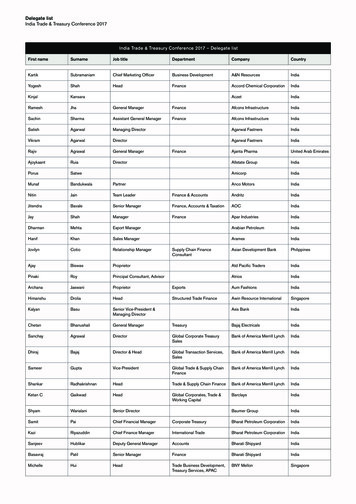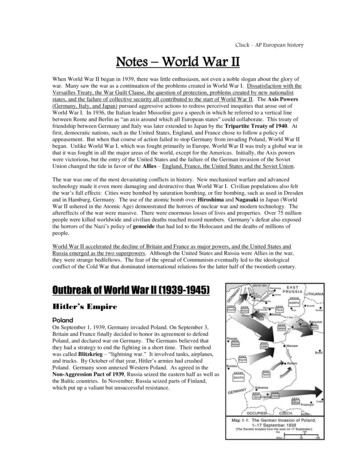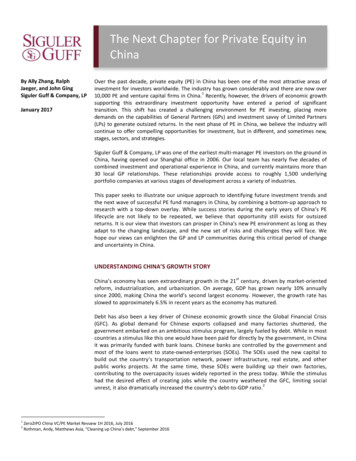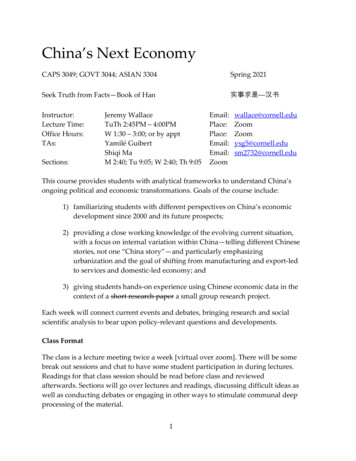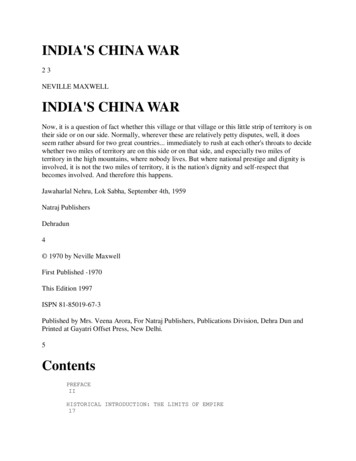
Transcription
INDIA'S CHINA WAR23NEVILLE MAXWELLINDIA'S CHINA WARNow, it is a question of fact whether this village or that village or this little strip of territory is ontheir side or on our side. Normally, wherever these are relatively petty disputes, well, it doesseem rather absurd for two great countries. immediately to rush at each other's throats to decidewhether two miles of territory are on this side or on that side, and especially two miles ofterritory in the high mountains, where nobody lives. But where national prestige and dignity isinvolved, it is not the two miles of territory, it is the nation's dignity and self-respect thatbecomes involved. And therefore this happens.Jawaharlal Nehru, Lok Sabha, September 4th, 1959Natraj PublishersDehradun4 1970 by Neville MaxwellFirst Published -1970This Edition 1997ISPN 81-85019-67-3Published by Mrs. Veena Arora, For Natraj Publishers, Publications Division, Dehra Dun andPrinted at Gayatri Offset Press, New Delhi.5ContentsPREFACEIIHISTORICAL INTRODUCTION: THE LIMITS OF EMPIRE17
(i) The Western Sector(ii) The McMahon Line39ICOLLISION COURSE65(i) The Course is Set67(ii) Evasive Action135IITHE FORWARD POLICY171IIITHE VIEW FROM PEKING257IVTHE BORDER WAR289(i) The Ridge and the River291(ii) Between Two 46367List of MapsGeneral maps of the western and middle sectors and the eastern sector of the Sino-Indian bordersare in the front and back endpapers, respectively.between pagesHistorical development of western sector boundary 40 and 41Historical development of eastern sector boundary 64 and 6519
Conflicting claims in the western sector 168 and 169The forward policy in the western sector 156 and 257The battle of Thag La ridge 360 and 361The battle of NEPA 416 and 41789TO EVELYN10 11PrefaceThe Sino-Indian boundary dispute was one of the most dramatic passages of internationalrelations in the mid-twentieth century. It saw the world's two most populous states, Asia's greatnew republics, which had seemed to be set on a path of amicable co-operation in spite of theiropposed political characters, fall out over tracts of desolate, difficult and useless territory, andultimately fight a short, fierce border war. It sharply reduced the role and status of India in worldaffairs. Friendship with China had been the keystone of the foreign policy Jawaharlal Nehru hadset for India: non-alignment, the refusal of India to throw in her lot with either of the blocks,Communist and anti-Communist, into which the world seemed then so neatly divided; selfreliance in defence, independence in foreign policy; concentration upon economic development,at the risk of allowing the armed forces to run down-all of these depended upon friendship withChina, and a peaceful northern border. Hostility with China, a live border in the north demandinghuge defence outlays—these would bring down the whole arch of Nehru's policies. With themwould go Nehru's political dominance.The dispute, and the border war which was its climax, confirmed the general view of China as abellicose, chauvinist and expansionist power. When, at the end of the decade, the Sino-Sovietboundary dispute became acute and those giants began to move towards war, recollection ofChina's quarrel with India predisposed world opinion to accept the Russian version of the newdispute, and even encouraged the thought that China might now be getting what she deserved forher general intransigence over border questions. Of all recent quarrels between nations, none hasbeen so fully documented as that between China and India: both sides explained their positions atgreat length and repeatedly, to each other and for anyone else who would listen. And yet thefacts beneath the dispute seemed so obscure—and so few were ready to inquire into themobjectively—that no recent international incident has been so widely and totally misunderstoodas this.My interest in the subject began with my arrival in New Delhi to12
take up the assignment there as correspondent of The Times at the end of August 1959, when Iimmediately became engaged as a reporter in the events which this book recounts. The Longjuincident, the first armed clash on the Sino-Indian border, had occurred a few days before Iarrived; and for the next three years, until after the climax of the border war, India's dispute withChina, with all its ramifications, was a staple of my work.I first came to rewrite the story of the Sino-Indian dispute as a section of a book I had planned onIndia in the 1960s, hingeing on the death of Nehru in 1964. Initially I saw this as a matter ofrecasting and elaborating the tens of thousands of words I had written on the dispute as itdeveloped, in my dispatches; but as I read again through the evidence in the diplomatic argumentbetween the two Governments, set out in the long series of Indian White Papers, I realized thatsomething much more full, fundamental and searching was required. This book is the product ofmy subsequent reappraisal. Its basic inspiration remains, however, my personal knowledge of thedispute as it was handled and felt in New Delhi. Personalities, in action and interaction, attitudes,even moods, played an important part in the dispute, and in the related political developments inIndia—and it is here, perhaps, that the journalist who watched the events has an advantage overthe scholar coming later to the trail, when the evidence lies on paper only, and the smiles andfrowns, the tones of injury or pride, the unregistered asides, have been forgotten.Until I left India in mid-1967 I pursued my re-inquiry in long and repeated interviews with thepoliticians and officials who had been responsible for India's handling of the dispute, and withthe soldiers who had tried to give military expression to their Government's policy. When I cameas a senior fellow to the School of Oriental and African Studies in London to complete this studyand write the book, I tried first to put the subject into historical context: to see it not only as thecollision of the two greatest Asian powers of the mid-twentieth century, but also as thecontinuation of one hundred and fifty yean of political, military and diplomatic manoeuvringacross and around the Himalayas. During the 1960s historians and other scholars had done muchto elucidate the history of the Himalayan zone and of the borders that lie within it, and I havedrawn on their work for the first section of the book. This traces the history of the disputedboundaries, and is essential, I think, for the understanding of what follows.13The scheme of the book is roughly chronological, but there are frequent overlaps in the differentsections. An incident touched upon in one may be frilly developed in another; or an event toldfrom one point of view in one section may in the next be retold from the opposite side. Thesection, 'The View from Peking', is an attempt to see the dispute through Chinese eyes, andtouches again on many of the developments described in the two previous sections. This attemptwas required, I believe, because the whole dispute has so consistently been seen from the Indianpoint of view: and, as one Englishman observed of another early in the century, 'it is no doubtdifficult to convince anyone from India that there is a Chinese point of view which deservesconsideration.'*Wherever possible, I have given references for statements or quotations; but it will be seen thatthe density of such notes falls off sharply in the sections dealing with the border war and itspreliminaries. In those (and at some other points in the book) I have drawn on material from
unpublished files and reports of the Government of India and the Indian Army: I was givenaccess to these by officials and officers who believed that it was time a full account was puttogether, and who trusted me to write it fairly. I cannot, of course, name them, nor cite thedocuments or files from which I have drawn the material; I can only thank them, and hope theywill not be disappointed.D. R. Mankekar, in his research for a history of the post-independence Indian Army, wassimilarly given access to unpublished files, and I am grateful to him for allowing me to quotefrom his original transcription of a crucial memorandum.I have tried to understand what motivated both parties in the dispute —and believe I havesucceeded to the extent, at least, that it can be seen that sometimes misunderstanding of theother's position played its part in accentuating the differences between New Delhi and Peking.My intention has been only to narrate and clarify a historical incident which I believe has beenwidely misunderstood, and which I myself misunderstood while it was happening. I have notmeant to indict either side and indeed believe it can be seen that both often acted from motives ofinjured rectitude—which of course served only to sharpen the conflict.One unavoidable imbalance in the book derives from the fact that my access to information hasbeen immensely freer on one side of the* See p. 53 below.14dispute than on the other. India must be one of the most open societies in the world so far as itspolitical processes are concerned, and in my research for this book I have greatly benefited fromthat virtue. But in this instance the Indian Government, in the short run at least, has perhapssuffered by its openness. A close scrutiny of the relationship between public words and private—indeed secret—attitudes rarely puts any government in anything but an invidious light; andNehru, whose on-the-record utterances were so prolific, must be particularly vulnerable to thecount of inconsistency, and transparent in his deliberate ambiguities. In contrast, no governmentis more secretive as to its inner processes than that of the People's Republic of China, and intracing Chinese policy formulation I have had nothing to go on beyond what is on. the publicrecord. That is unusually full, but of course it must wholly omit the evidence of hesitation,inconsistency and division— and even dissimulation—which sometimes emerges from therecord of the inner deliberations of the Indian Government and military. China's policy thereforeprobably looks far more monolithic, perhaps even more pragmatic, than it would if one had inPeking the sort of access I have had to Indian records. Perhaps future students of these eventswill be able to repair this imbalance, and, with fuller documentation at their disposal, will revealinadequacies in the narrative and errors in interpretation.I owe the opportunity to devote nearly two years to writing this book to the School of Orientaland African Studies of London University, and especially to its director, Professor C. H. Philips,whose interest, encouragement and advice were invaluable to me.
Among others whom I especially thank are: Ronald Segal, who has encouraged and counselledme in many matters concerning this book; Dr S. Gopal, whose encouragement to write the bookhas never been weakened by his certainty that he will totally disagree with it; Professor MichaelBrecher, for a rigorous reading of the MS.; Professor Alastair Lamb, who also helpfully read theMS., and let me cite an unpublished paper of his on Aksai Chin; and Professor John KennethGalbraith, who from his own immediate knowledge of these events pointed out some errors ofdetail and emphasis. Miss Dorothy Woodman allowed me to draw on some new material in herHimalayan Frontiers; Kuldip Nayar gave me an advance reading of his book, Between the Lines;Professor Robert Huttenback read and commented upon my historical introduction; DavidWilson, editor of China15Quarterly, and Richard Harris, Far East specialist of The Times, read and commented upon mysection on the Chinese view of the dispute; John Addis permitted me to quote from hisunpublished Harvard paper on the Sino-Indian dispute. The maps are by D. R. Baker. Graham C.Greene's interest in my writing, long sustained, has been a steady prop. Dr A. P. Rubin helpfullyread my final draft. I am grateful to all these.Responsibility for errors or misjudgments remains, of course, my own.16 17Historical Introduction THE LIMITS OFEMPIRE18 19(i) The Western SectorFollowing the logic of power, empires in their expansive phases push out their frontiers untilthey meet the resistance of a strong neighbour, or reach a physical barrier which makes a naturalpoint of rest, or until the driving force is exhausted. Thus, through the eighteenth and nineteenthcenturies, British power in India expanded, filling out its control of the peninsular sub-continentuntil it reached the great retaining arc of the Himalayas. There it came into contact with anotherempire, that of China. In the central sector of the frontier zone, where lay petty states andfeudatories, there began a contest for dominance over these marcher lands that continues to thepresent day. In the north-west and the north-east, where no minor, independent polities existed toact as buffers, the British sought secure and settled boundaries with China: these they failed toachieve, and the failure was to lead in the middle of the twentieth century to the border warbetween India and China.***********
As the advancing British frontier approached the great knot of the Hindu Kush and theKarakoram mountains in the north-west, so Imperial Russia advanced towards the same pointfrom the other side. The same process made for the advance of both powers, conquest entailingthe need for further conquest. The Russians explained the compulsion behind their advance:. . . Russia had found herself brought into contact with a number of semi-savage tribes, whoproved a constant menace to the security and well-being of the empire. Under thesecircumstances, the only possible means of maintaining order on the Russian frontier was to bringthese tribes into subjection; but as soon as this had been accomplished it was found that the newconverts to civilisation had in turn become exposed to the attacks of the more distant tribes. Andso it became necessary to establish fortified20posts among the outlying peoples, and by a display of force to bring them into submission.1More pithily and less apologetically, an Englishman later described the imperial drive forexpansion as 'the natural impulse of the civilised to overrun the uncivilised on their borders.2 Butalthough these approaching empires were both in fact subject to the same compulsion toexpansion, each concluded that the other was advancing in deliberate menace. The expectation ofcollision informed frontier policy in both St Petersburg and London.A constant and basic British aim developed: to keep the Russians as far as possible from theplains of India and their politically volatile cities; but the tactics varied in accordance with theattitudes of those setting policy in London and in India, and with the significance these attachedto the role of the third factor in all their calculations—China. There were two principal schoolsof frontier policy: first, the forward school, which wished to see Britain advance to meet theRussian threat directly and as far away from the plains as possible; second, the moderate school,which pointed to the cost and risk of trying to establish boundaries in remote and immenselydifficult country, suggested that the limits of British power should be set where they could moreeasily be supported, and proposed that the aim of keeping Russia back could best be served byinterposing a third power between the lion and the bear. There were various possible players forthat role: Afghanistan was one; sometimes small states such as Hunza looked likely; but,throughout, it was recognized that China, established in the area a century before British orRussian power reached there, would best be fitted for the part—if the Chinese were capable of it,and if they could be persuaded to play. But there, the British were to discover, was the rub.Perhaps it was because experience with Russia had taught China that, in the hands of herimperial neighbours, boundary treaties were blades with which Chinese territory could be paredaway; but in any event, the Chinese shied away from most British attempts to settle commonboundaries with them.The history of British boundary policy in the north-west is an alternation of the forward andmoderate schools in influence in London and India. These shared, however, a common purpose,the creation of a linear boundary. This was something required by modern states, but unfamiliarand even alien to their predecessors; to those, a sovereignty
21that shaded off into no-man's-land, giving a frontier of separation rather than contact, was bothmore familiar and more natural. 'The idea of a demarcated frontier is itself an essentially modernconception, and finds little or no place in the ancient world', Lord Curzon observed at thebeginning of this century, pointing out that, until then, 'it would be true to say that demarcationhas never taken place in Asiatic countries except under European pressure and by theintervention of European agents.'3 But a distrustful China was, for the most part, able to resist orevade British pressure, and so, at both ends of the Himalayas, no-man's-lands still separatedChina and India when these became independent in the mid-twentieth century; their quarrel arosefrom the need to translate those zones into lines, and from the failure to agree on a method.In the nineteenth century the border with China in the north-west did not much concern theBritish. Their attention was focused on the border with Afghanistan, and on the Russian threatthat was believed to lie beyond it, and the pendulum of official favour swung between forwardand moderate policy in that regard for decades. To the moderates, 'the natural and impregnableboundary of our Empire' was the Indus River.4 But with the annexation of the Punjab in 1849 theBritish, inheriting the domains of the conquered Sikh kingdom, advanced their power to themouth of the Khyber pass, where they felt imperial logic beckoning them on to Kabul, and fromthere, perhaps, to Herat. The strategic argument of the forward school could hardly be better putthan it was by Lord Curzon:India is like a fortress, with the vast moat of the sea on two of her faces and with mountains forher walls on the remainder; but beyond these walls, which are sometimes of by no meansinsuperable height, and admit of being easily penetrated, extends a glacis of varying breadth anddimension. We do not want to occupy it, but we also cannot afford to see it occupied by our foes.We are quite content to let it remain in the hands of our allies and friends, but if rivals creep upto it and lodge themselves right under our walls, we are compelled to intervene because a dangerwould thereby grow up which might one day menace our security. . . . He would be a shortsighted commander who merely manned his ramparts in India and did not look beyond.5By 1880, however, the attempt to occupy the Afghan glacis of empire22had led, as London complained, to two wars, 'the employment of an enormous force and theexpenditure of large sums of money [while] all that has yet been accomplished has been thedisintegration of the state which it was desired to see strong, friendly and independent."8 Theforward school suffered eclipse, the moderates, with their prescription that Afghanistan shouldbe a buffer state, held sway in Whitehall; and the British, relinquishing Kandahar, withdrewagain behind their mountain ramparts. The problem became one of stabilizing Afghanistan,settling boundaries for it with Russia and Persia,* and then of agreeing with the Afghans on aboundary between themselves and the British; and that was not so easy.The limits of British administration lay along the foot-hills, beyond which the turbulent andmartial Pathan tribes made any British incursion costly and ineffective. But the Afghans claimed
sovereignty over those tribes, and exerted at least influence over them; thus, to apply Curzon'sphrasing, creeping over the wall and lodging themselves inside it, where they could threatenPeshawar and the trans-Indus territories. British policy was therefore directed to excludingAfghan claims from as much of the tribal territory as possible. The outcome was an agreement in1893 in which the Amir of Afghanistan accepted a boundary drawn by the British along the crestof the mountains: the Durand Line, named after the Englishman who negotiated it.The Afghans seem to have regarded the Line as something of a one-way-traffic sign, with theNO ENTRY side facing the British, since they continued to deal with the tribes across it. TheBritish had no intention at the time of advancing their administration to the Durand Line; theysaw that as a means of excluding the overt presence of the Afghans, not as a step towardsexpanding British territory. As boundaries go, the Durand Line was not a good one, being'illogical from the point of view of ethnography, of strategy and of geography';7 but it served theBritish purpose. The Afghans were treaty-bound to keep well back from the practical limits ofBritish administration, and the Durand Line gave Britain a purchase from which to protest ifAfghan* Afghanistan had good reason to be pleased with the boundaries which the British and Russiansgave her—for their own purposes, of course. The British helped the Afghans keep the Persiansback from Herat; agreement between London and St Petersburg gave the Afghans a northernboundary along the Oxus, over territories which, had it not been for the desire shared betweenRussia and Britain to preserve Afghanistan as a buffer, would almost certainly have gravitatedtowards the Russian sphere. Only the Durand Line left the Afghans dissatisfied. For a discussionof Afghanistan's boundaries see Lamb, Asian Frontiers (Pall Mall Press, London, 1968), pp. 86ff.23influence in the tribal territory became too assertive; the Russians were, by and large, respectingAfghanistan's buffer status; and although the Pathan tribes remained a problem for the British tothe very end of their rule in India, the Durand Line survived. It was demarcated* along a gooddeal of its fifteen-hundred-mile length, that extremely arduous task being ably performed by aCaptain Henry McMahon, who had been a member of Durand's 1893 mission to Kabul—and ofwhom this account will later have more to tell.If the problem of the light-triggered Pathan tribes made the Afghan sector of the north-westfrontier the most troublesome for Britain in the nineteenth century, the Kashmir sector, where thefrontier marched with Sinkiang and Tibet, also from time to time attracted the attention of thestrategists and statesmen in London and India.Kashmir fell to Britain in 1846 as one of the fruits of the first Sikh war; but, rather than try tooccupy it themselves, the British opted to set up Kashmir as the 'guardian of the northernfrontier, without the hostility, expense and added responsibilities which its annexation wouldinvolve'.8 (The Governor-General of the time thought that an attempt at annexation would merit'a straitwaistcoat and not a peerage'.9) Accordingly, they made over Kashmir to Gulab Singh, alocal Dogra ruler whom the Sikhs had made Governor of the hill state of Jammu, but who had
turned his coat to the service of the British. Thus they created the state of Jammu and Kashmir—setting Hindu rulers over a Muslim people and planting the seed of the bitter quarrel between theheirs to their power on the sub-continent—and thus, as that border-conscious proconsul LordCurzon put it, they 'carried the strategical frontier into the heart of the Himalayas'.10 Thathappened because the Treaty of Amritsar left Gulab Singh under the suzerainty of Britain andbecause Gulab Singh, himself no mean empire-builder in a small way, had, several years before,conquered the little kingdom of Ladakh.Ladakh, lying in the valley of the upper Indus at an altitude of twelve thousand feet and more,was part of Tibet up to the tenth* Although even recent dictionanes give the words 'demarcate' and 'delimit' as synonyms, theyhave taken on distinct meanings; the distinction, crucial to clarity in any discussion ofboundaries, was drawn by Henry McMahon in 1897. As he spelled it out later:' "Delimitation" Ihave taken to comprise the determination of a boundary line by treaty or otherwise, and itsdefinition in written, verbal terms; "Demarcation", to comprise the actual laying down of aboundary line on the ground, and its definition by boundary pillars or other physical means.'11 Inthis book the words will always be used in these distinct meanings.24century, when it broke off as an independent kingdom. In the fourteenth century the conqueringtide of Islam reached Ladakh, to retreat, then return in the sixteenth century when the kingdombecame a tributary state of the Moghul empire.12 With the decline of the Moghuls, the Ladakhisagain asserted their independence; but, being Buddhist and within Lhasa's cultural and politicalpull, Ladakh tended to gravitate back to Tibetan overlordship in the absence of conquerors strongenough to pull it away. So, in the nineteenth century,Ladakh was probably best regarded as part of Tibet, and much on the same footing as other pettypolities located in the valleys of the Tibetan plateau; all owed some sort of obedience to theLhasa government, which derived its authority from the transcendental position of the DalaiLama and enforced it by the theocratic network of surveillance administered by the Lamaistmonastery organization. Tibet was at this time unquestionably under the control of China.13But in 1834 Gulab Singh's Dogras invaded Ladakh, to make it tributary, through himself, to theSikh rulers of the Punjab. They did not stop there, but embarked on what they intended as theconquest of Tibet, turning Lhasa's fealty towards Lahore rather than Peking.14 The Dograsmarched in the spring of 1841 and, crushing Tibetan forces sent against them, by the end of thesummer were in possession of all the territory up to and including the sacred lakes of Rakas Taland Manasarowar—territory which, not incidentally, gave the Sikh kingdom control of the areasfrom which came most of the wool for the rich cashmere shawl trade. Indian historians haveacclaimed this campaign as a brilliant feat of arms, and with gratification noted that it wascarried out beyond the natural mountain barriers of Hindustan;15 but the Dogra general rashlydecided to winter in Tibet, was besieged and —'marooned at a height of twelve thousand feet inthe midst of a vast sea of drifting ice and snow'16—was in due course killed with all his force.The Tibetans then advanced to liberate Ladakh, but themselves suffered a reverse just short of
Leh at the hands of Gulab Singh's reinforced army. With the honours of war even, the leaders ofthe two forces in October 1842 signed what was in effects non-aggression pact. This bound eachto respect the territory of the other—but it did not specify a boundary between them, referringonly to 'the old, established frontiers'.17 That this imprecise formulation was acceptable to the25Tibetans and the Dogras seems to reflect that fact that their domains, although neighbouring,were not clearly contiguous; either would have had to dispatch an expeditionary force to attackthe other, first crossing mountainous no-man's-land. Each side would have had a general idea ofwhere its own frontier lay; but, as the two frontiers were separated, there was no need to specifythem—nor, in all probability, could they have been specified, so rudimentary were the parties'ideas of geography.*The British had watched Gulab Singh's abortive foray with concern, alive to the danger thatChina would 'impute the invasion of its territories by the Sikhs [whom Gulab Singh served] tothe instigation of the British Government',18 and react accordingly against Britain. They hadthose recent misgivings in mind when, in 1846, they recognized Gulab Singh as Maharajah ofJammu and Kashmir, and were apprehensive that 'the hope of plunder and the desire ofrevenge'19 might tempt him to try another attack on Tibet, with an increased likelihood thatBritain would be embroiled. Accordingly, the Treaty of Amritsar forbade Gulab Singh fromadding to his territory without British consent; and, to make sure that he did not do so byclandestine expansion, it provided for the demarcation of the boundary between Tibet andLadakh—and thus, the British hoped, removal of 'the most common cause of all disputes in theeast—an unsettled boundary'.20The British informed the Chinese Government of the proposed boundary demarcation andinvited it to participate, writing both to Lhasa and to the viceroy in Canton of the Chinese CentralGovernment. There was no British mission in Peking at this time, and it was very difficult evento contact the Chinese Government, let alone to elicit any reply. The nearest to a reply the Britishreceived on this occasion was the evasive observation by the Canton viceroy that 'the borders ofthese territories [i.e. Tibet and Ladakh] have been sufficiently and distinctly fixed, so that it willbe best to adhere to this ancient* That the 1842 agreement had any treaty force at all was vigorously denied by an Englishofficial who looked into it on the instructions of the Governor-General six years later. He pointedout that the Tibetan signatories had been 'commissioned to exterminate the Dogra invaders ofTibet and not to make treaties with them', and that the agreement, 'extorted from [the Tibetans]under the pressure of a reverse', had not been ratified by either Government. Even before thatreport was made, Lord Hardinge had unilaterally cancelled sections of the 1842 agreement whichhe judged injurious to Britain's interest— an action that could, it seems, be consideredtantamount to abrogation of the whole agreement.2126
arrangement, and it will prove far more convenient to abstain from any additional measures forfixing them.'22 Later this Chinese
China, and a peaceful northern border. Hostility with China, a live border in the north demanding huge defence outlays—these would bring down the whole arch of Nehru's policies. With them would go Nehru's political dominance. The dispute, and the border war which was its climax,


